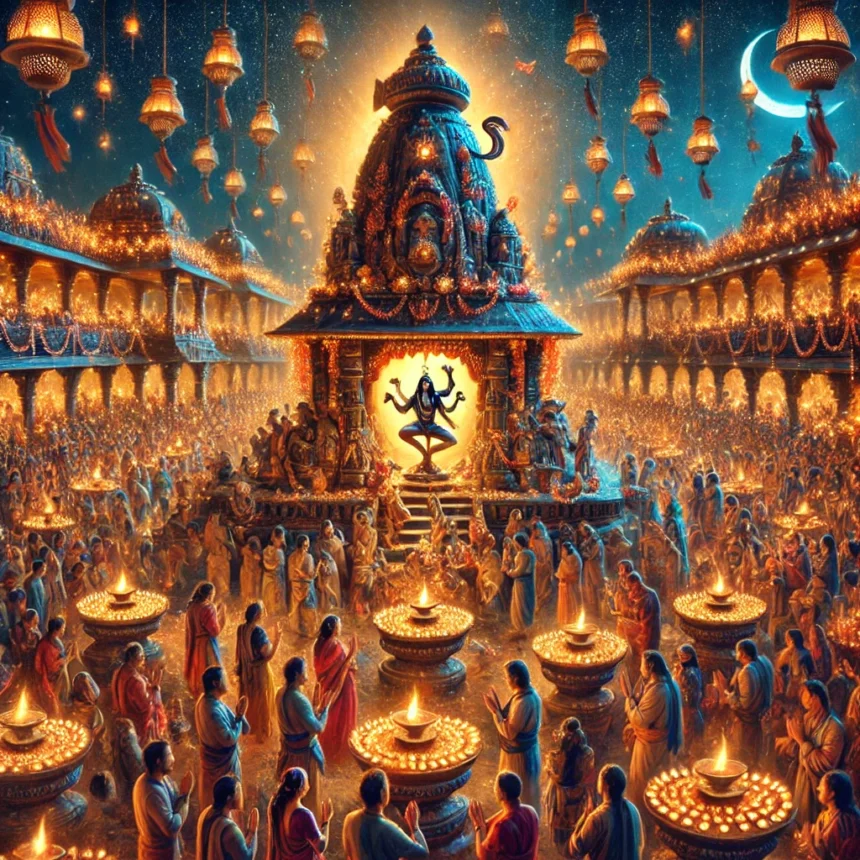Festivals of Lord Shiv: A Devotional Journey-II
Spiritual Journey of Festivals of Lord Shiv
Embarking on the second part of our series on the Festivals of Lord Shiv, we delve into the observances of Ardra Darshan, Kartik Purnima, and Karva Chauth. This segment explores the varied and rich traditions associated with each festival, showcasing how Lord Shiv’s influence extends across different regions and cultural practices within Hinduism. From celestial dances to marital vows, these festivals highlight Shiv’s roles in promoting prosperity, upholding marital fidelity, and maintaining cosmic balance. Join us as we explore these diverse celebrations in depth.
Ardra Darshan
Transitioning into Ardra Darshan, we observe how celestial phenomena align with spiritual reverence, marking Lord Shiv’s cosmic dance during the Tamil month of Margazhi.
Ardra Darshan is a profound observance within the Festivals of Lord Shiv, celebrated during the Tamil month of Margazhi. This festival honors Lord Shiv’s cosmic dance, symbolized by the Ardra nakshatra, reflecting a deep connection between celestial movements and spiritual enlightenment.
Date and Significance
Ardra Darshan occurs when the moon aligns with the Ardra star in the Tamil month of Margazhi or Magh (December-January). This alignment is believed to emanate powerful cosmic energy, making it an auspicious time for devotees to seek spiritual growth and blessings from Lord Shiv.
Cultural and Spiritual Background
The textual references of Ardra Darshan centers around Lord Shiv’s dance of destruction and recreation, which is said to sustain the universe’s cycle. This dance is celebrated as Nataraja’s dance and is a key spiritual symbol in Saivism, representing the rhythmic balance in life and the universe.
Rituals and Practices
On Ardra Darshan, devotees perform elaborate rituals including an Abhishekam (sacred bath) of Lord Shiv with holy water, milk, honey, and other auspicious materials. This is followed by the offering of prayers, chanting of hymns, and meditation, often throughout the night.
Cultural Impact
Ardra Darshan significantly influences Tamil culture by fostering a deep appreciation for classical arts, particularly classical dance, which is closely associated with Shiv as Nataraja. It’s a time when dance performances are held to honor the divine dancer, integrating cultural expression with religious devotion.
Regional Variations
While Ardra Darshan is primarily celebrated in Tamil Nadu, its observation might vary slightly across different regions, with some focusing more on dance and others on ritualistic worship.
Famous Regions and Temples for Celebration
The festival is especially prominent in Chidambaram, home to the Nataraja Temple, where Shiv’s dance is believed to have been performed. The temple attracts thousands of devotees during this festival, making it a pivotal event in the Festivals of Lord Shiv.
Kartik Purnima
As we shift our focus to Kartik Purnima, the dual significance for both Vishnu and Shiv devotees emerges, underscoring the holistic approach to divine celebration in Hinduism.
Kartik Purnima holds dual significance for both Vishnu and Shiv devotees, being a part of the Festivals of Lord Shiv. This day is revered for astronomical importance, celebrating the divine in various forms.
Date and Significance
Celebrated on the full moon day of the Hindu month of Kartik, this festival is important for Shiv worship as it symbolizes the victory of light over darkness and knowledge over ignorance, themes central to Shiv’s teachings.
Cultural and Spiritual Background
Kartik Purnima is linked with legends of Shiv destroying demons and thus is considered a powerful day to seek his protection and blessings. The day is marked by lighting diyas (lamps) which signify the light of consciousness Shiv brings into the world.
Rituals and Practices
Devotees often undertake pilgrimages to Shiv temples, take holy dips in rivers, and perform Puja and Arti at sunrise and sunset. The lighting of lamps is a significant ritual, representing illumination within and around.
Cultural Impact
The communal gatherings on Kartik Purnima serve as spiritual sessions that reinforce community ties and collective devotion, reflecting the societal structures influenced by spiritual practices.
Regional Variations
Each region may add its unique customs to the celebration; for instance, in Varanasi, the festival includes a special Ganga Arti and cultural performances along the riverbanks.
Famous Regions and Temples for Celebration
Major Shiv temples like Somnath in Gujarat and Kashi Vishwanath in Varanasi see heightened activity during Kartik Purnima, drawing devotees from across the nation to participate in the sacred festivities.
Karva Chauth
Finally, we delve into Karva Chauth, a festival deeply rooted in marital devotion, which also embraces Lord Shiv’s principles, blending individual spiritual practices with communal harmony.
Karva Chauth, traditionally known for its significance among married women, also intertwines with the Festivals of Lord Shiv. This festival sees women praying for the longevity and prosperity of their husbands, and in some regions, Lord Shiv, Parvati, and their son Kartikeya are also worshipped, symbolizing the ideal familial relationships.
Date and Significance
Karva Chauth is observed on the fourth day after the full moon in the Hindu month of Kartika. While predominantly celebrated for marital bliss, in regions where Lord Shiv is venerated, it also encompasses prayers to Shiv and his family, seeking their blessings for marital harmony and family welfare.
Cultural and Spiritual Background
In the context of Festivals of Lord Shiv, Karva Chauth involves rituals that include both Shiv and Parvati, emphasizing their role as divine parents and the epitome of marital fidelity. The narrative of Parvati’s devotion and austerity to win Shiv’s affection is recited, serving as a spiritual model for married couples.
Rituals and Practices
The day is marked by strict fasting from sunrise to moonrise, with no food or water consumed by the observing women. Rituals include offering prayers (puja) to Shiv and Parvati, with the chanting of Shiv-Parvati stotras and katha (stories) that narrate the significance of their union.
Cultural Impact
Karva Chauth strengthens marital and familial bonds through its rigorous observances and communal rituals. The involvement of Shiv in these rituals enhances the festival’s spiritual depth and reinforces the sanctity of marital vows within the community.
Regional Variations
While predominantly a North Indian festival, the inclusion of Shiv worship during Karva Chauth is more prominent in regions with a strong tradition of Shiv devotion. These variations often reflect local legends involving Shiv and Parvati.
Famous Regions and Temples for Celebration
Places like Haridwar and Varanasi, where Shiv worship is deeply ingrained, observe Karva Chauth with significant fervor. Temples in these regions hold special pujas and gatherings, making them focal points for celebrations.
Reflections on Festivals of Lord Shiv
In wrapping up our series on the Festivals of Lord Shiv, we have traversed through a spectrum of rituals and celebrations that highlight Lord Shiv’s role in Hindu texts and worship. From the celestial alignments of Ardra Darshan to the community gatherings of Kartik Purnima and the marital prayers of Karva Chauth, these festivals not only honor Shiv but also promote essential societal values and personal well-being. They serve as a testament to the enduring legacy of Shiv’s influence in guiding spiritual practice and communal harmony across generations.
Feature Image: Click here to view the image.
Top Searched #Tags: #FestivalsOfLordShiv #ShivaFestivals #HinduFestivals #SpiritualJourney #IndianCulture
Glossary of terms
- Ardra Darshan: A festival celebrated during the Tamil month of Margazhi, honoring Lord Shiv’s cosmic dance. It is associated with the Ardra nakshatra, a star considered significant in Hindu astrology.
- Nataraja: A depiction of Lord Shiv as the cosmic dancer, who performs the divine dance to destroy a weary universe and make preparations for the god Brahma to start the process of creation.
- Abhishekam: A Hindu ritual of bathing a deity with sacred substances like milk, honey, and water during worship, often used in rituals dedicated to Lord Shiv.
- Chidambaram: A city in Tamil Nadu known for the Nataraja Temple, which is considered one of the holiest shrines in India dedicated to Lord Shiv.
- Kartik Purnima: A Hindu festival celebrated on the full moon day of the lunar month Kartik. It has significance for both Vishnu and Shiv devotees, often marked by lighting lamps and undertaking pilgrimages.
- Diyas: Small lamps, typically made from clay, with a cotton wick dipped in ghee or vegetable oils, used during Hindu festivals like Kartik Purnima to symbolize the victory of light over darkness.
- Puja and Arti: Ritualistic worship performed in Hinduism, involving offerings to deities, invocation of gods, and recitation of their praises.
- Karva Chauth: A festival celebrated predominantly by married women in North India, where women fast from sunrise to moonrise praying for the longevity and prosperity of their husbands.
- Katha: A recital of a religious story during Hindu rituals, which during Karva Chauth involves the tales of Parvati and her devotion to Lord Shiv.
- Stotras: Hymns of praise, which in the context of the Festivals of Lord Shiv, involve chants dedicated to Shiv and Parvati to invoke their blessings.
Other Blogs Related to Hindu Festivals
Vishnu Avatars: Celebrating Five Divine Festivals
Avatars in Revelry: Exploring the Spiritual Festivals of Divine Forms
Festivals of TriumphCelebrating Divine Victory and Spiritual Renewal
Rama Avatar: Sacred Celebrations of Lord Rama’s Legacy
Krishna Avatar: Divine Festivals of Joy and Devotion-I
Krishna Avatar: Divine Festivals of Joy and Devotion-II
Radha Rani: Celebrating the Divine Festivals of Love and Devotion
Durga Festival Celebrations of Divine Femininity and Power
Festivals and Celebrations of Female Deities: A Journey Through Tradition
Festivals for Hindu Female Deities: A Journey Through Tradition
Festivals of Lord Shiva: A Devotional Journey-I
Other Relevant Blogs
Hindu Festivals and Fastings: The Essence of Dharma
Maha Shivratri- Maha Festival



Leave a Reply